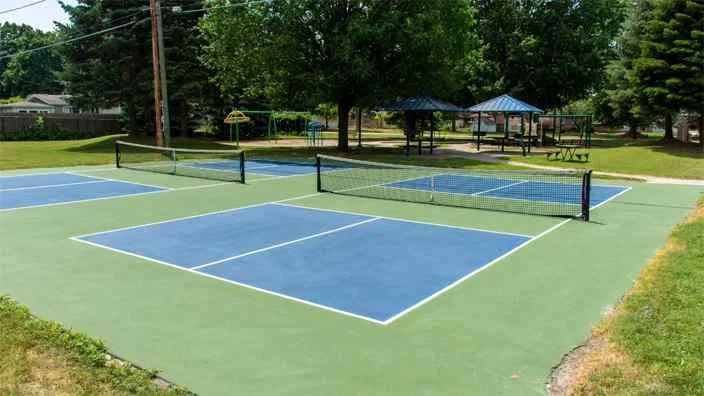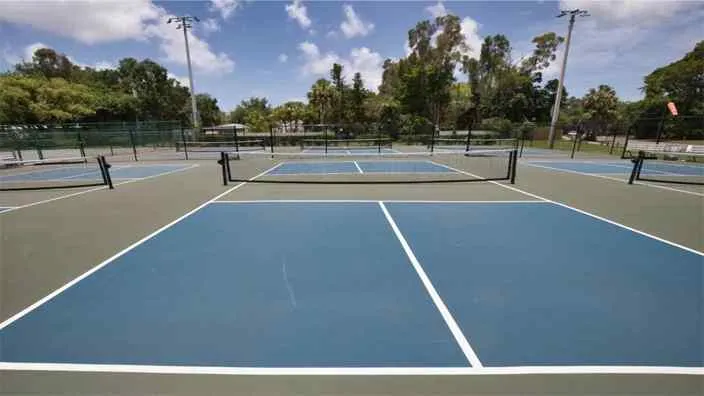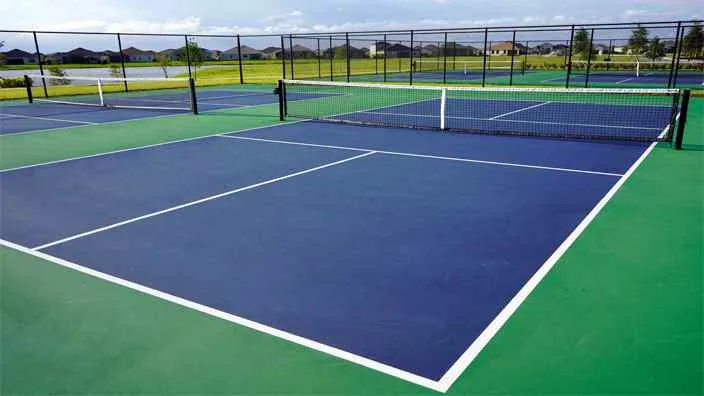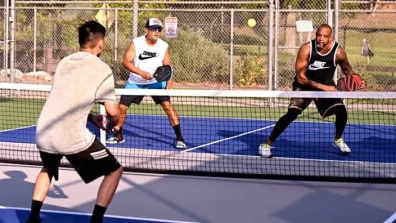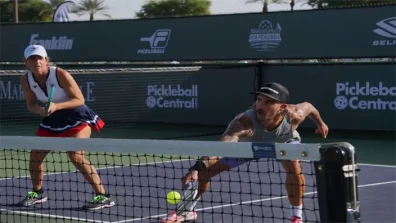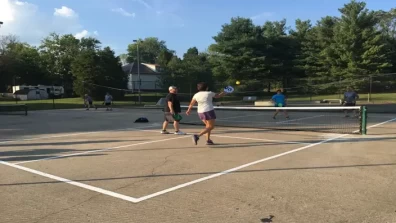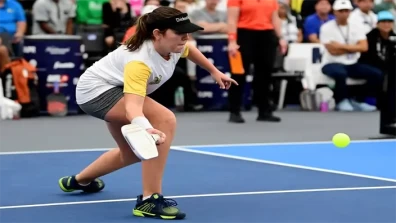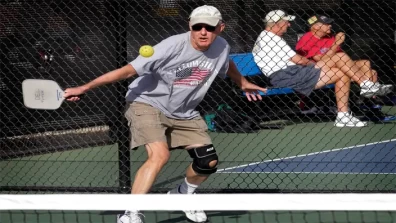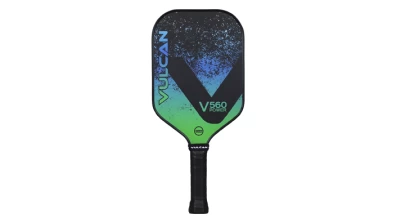Are you a pickleball enthusiast with dreams of having your very own court? But do you know having a pickleball court in your backyard can boost your property’s value? Over the last year, more than 36.5 million people engaged in pickleball, as reported by the Association of Pickleball Professionals.
The rising popularity of pickleball has sparked a surge in interest in personal courts. However, the financial puzzle of building one can leave you wondering where to begin. In this article, I’ll share the cost considerations of both indoor and outdoor pickleball courts. You’ll get a clear picture of the factors affecting these costs.
Table of Contents
Unveiling The Expenses: Building Your Own Pickleball Court
The average rate of building an outdoor standard-size pickleball court starts from $20,000 and can go beyond $50,000, depending on size and location. Other factors that affect the cost of the court include its surface material and type, foundation, design, and amenities. Here’s how these factors affect the overall expenses of building an outdoor pickleball court:
1- Court Size
A standard pickleball court size is 20 feet by 44 feet. It should include a 7-foot room called the non-volley zone on both sides of the net and spanning its entire width. Another suitable size for a pickleball court is 30 feet by 60 feet, with 5 feet of room on each side and 10 feet of clearance on each end. Yet, for safety and a more comfortable experience, it’s a good idea to provide some extra space around the court. However, larger or custom-sized courts will come with a higher construction cost.
2- Location
Where you decide to put your pickleball court matters for the cost. It depends on where you’re considering building it because different places have different expenses. If you’re in a city where space is tight and land prices are high, getting or renting the land might cost you more. The labor costs will also be high. Plus, you might have to deal with extra things like zoning rules, permits, and inspections, which can add to the overall cost and time it takes to make your court.
3- Surface Type
What type of surface you build your court on is crucial for how it performs and how long it lasts. The land’s condition will also impact the costs. If it’s uneven, you might need to clear, level, or grade it to ensure a flat surface with a slight slope (around 0.833% to 1%) so rainwater won’t pool on it. For a small court, resurfacing could cost anywhere from $500 to $1,000. If it’s a regular-sized court, the range might be $3,000 to $10,000 or even more. On the flip side, if you need a complete resurfacing, it could total up to over $15,000. But in truth, how much does it costs to resurface a pickleball court also depends on the surface material you choose.
4- Surface Material
The surface material you pick for prepping the land is a significant factor in the cost. You’ve got choices like post-tension concrete, asphalt, concrete, modular tiles, or special pickleball court tiles. This choice affects both the upfront construction cost and the maintenance needs down the road. Asphalt is cheaper (approx $11-$22 per sq ft) and easier to put in than concrete.
But it doesn’t last as long and needs more attention. While concrete lasts the longest and requires the least upkeep, it’s also the most expensive (approx $9,000-$18,000 for a 30’ x 60’ court). Modular tiles are the cheapest (approx $2-$4 per sq ft) and simplest to set up. They’re usually made of sturdy plastic, ensuring a consistent ball bounce.
However, they’re not as robust and require more maintenance than concrete or asphalt. On the flip side, specialized pickleball court tiles are custom-made for the game. They meet professional standards, offering precise measurements, excellent grip, and sport-specific performance features. But they can be expensive (approximately $55,000 for a 30’ x 60’ court).
5- Foundation & Design
You’ve got to have a solid foundation for the court to last. Depending on the soil and the surface you pick, you might need extra work, like getting the ground ready, compacting it, and setting up drainage systems, making the project more expensive. Your court’s layout and where it’s situated might call for a more involved base or drainage setup.
Besides, it will probably cost more if you’re looking for a unique custom design with logos, special colors, or patterns. And if you want to include landscaping features around the court, like a viewing spot, trees, and bushes, that will drive up the cost, too.
Read More: Is Pickleball Easier Than Tennis?
6- Important Features & Amenities
You need fencing around the court and the right net system to play the game. Their costs can change depending on the materials and quality you pick. For accurate gameplay, you must also ensure the lines are done correctly. How you do it and the quality of the paint can affect the cost. Moreover, if you’re playing in the dark or in a place with limited daylight, you need lighting, which can be quite pricey, especially for indoor courts.
And if you want extra amenities like seating, shade, windscreens, or storage, that will add to the overall cost. These things make the experience better, but it’s good to budget separately for them. Other than these factors, indoor vs. outdoor installation also affects the expenditure of building a pickleball court.
Cost Of Indoor Pickleball Court
So, how much does it cost to build an indoor pickleball court? Indoor courts, like residential pickleball courts, usually cost more than outdoor ones because you must provide climate control and need special building materials. For instance, you might go with wood or rubber, which can be pricier than the usual asphalt or concrete on outdoor courts. Then, there are facility expenses. Indoor courts need a building or facility, which can drive up the costs.
This covers the construction or rent and ongoing expenses like heating, cooling, and upkeep. Also, indoor courts need artificial lighting, so you’re looking at higher initial installation expenses and ongoing electricity bills. A simple indoor court with cushioned vinyl flooring and court lines might begin at roughly $15,000 on the lower end. But for a top-of-the-line setup with full lighting, fencing, and all the bells and whistles, you could be looking at over $305,000.
Enhancing Property Value With Indoor Pickleball Courts
Indoor pickleball gear generally lasts longer compared to outdoor gear. This means you’ll have less cleaning, maintenance, and costs in the long haul. But does a pickleball court add value to your home? Yes, it does. Adding an indoor pickleball court to your home can potentially boost its value. In high-end real estate developments, pickleball courts are a sought-after amenity, and here’s why:
- Pickleball is booming, and having a court at your place could be a major selling point, especially for those keen on the game.
- A well-built pickleball court increases your property’s usable outdoor space.
- Older players might like the indoor court’s slower pace with no weather worries.
Economical Ways To Build Your Own Pickleball Court
If you’re on a tight budget, you can create a pickleball court right at your place. There are a few ways to make it happen:
- Temporary Court - Opt for a temporary setup in your backyard for as little as $100-500, including a portable net and some paint or tape for court lines.
- Outdoor Court - If you have enough space with an asphalt or concrete surface, a simple court can cost less than $500.
- Indoor Court - Convert an existing indoor basketball or tennis court.
Frequently Asked Questions
What Is The Cheapest Way To Make A Pickleball Court?
The cheapest way to make a pickleball court is to use a packed stone or gravel base with paint, and it can set you back about $3,000 to $5,000 for a 20’ x 44’ court. You could also consider a temporary court on an existing outdoor or indoor surface, which costs under $500. Another option is to utilize a current basketball or tennis court.
Is Pickleball A Profitable Game?
Yes, you can earn a decent income through pickleball. Some money-making avenues include coaching, running events, equipment sales, and owning facilities or clubs. Elite players can rake over a million dollars annually from appearance fees, prizes, and sponsorships.
Can I Make My Own Pickleball Court?
Yes, you can DIY your own pickleball court. The process includes measuring and marking, digging, adding forms, compacting soil and gravel, putting in rebar or mesh, pouring concrete, and letting it harden.
How Thick Is The Concrete For A Pickleball Court?
The best base for a concrete pickleball court is a 4’ thick concrete slab with 3000 PSI concrete and #4 rebar. When using hot-laid asphalt concrete on the sub-base, it should match the thickness and density of 4 inches of compacted crushed aggregate.
Can I Use Concrete For A Pickleball Court?
Yes, a concrete pickleball court is a solid choice. It’s durable, offers a smooth playing surface, and is low-maintenance and easy to keep clean.
What Kind Of Concrete Finish Is Required For A Pickleball Court?
Pickleball courts are often made using two concrete finishes: stamped and poured. Stamped is pricier but offers better durability and low maintenance. Whereas poured concrete is cheaper but less robust and prone to cracking over time.
Conclusion
Now that you’ve got the scoop on how much does it costs to build a pickleball court, remember many factors that affect its building cost. From court size to surface type, material, design, foundation, and location all play a big role in the expenditure. But if you’re budget-conscious, you can turn your backyard into a court on a shoestring budget. Or set up a temporary one for pickleball fun without breaking the bank.

